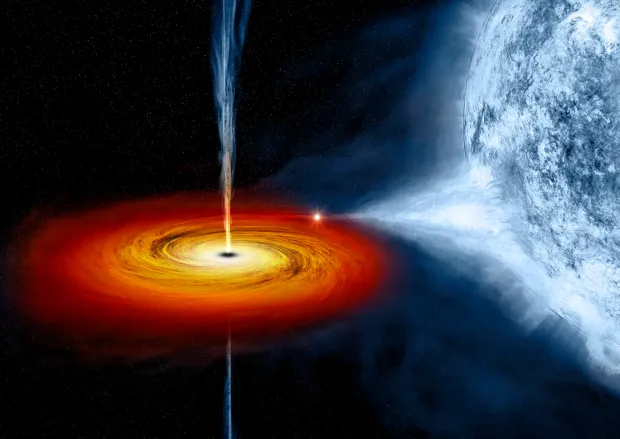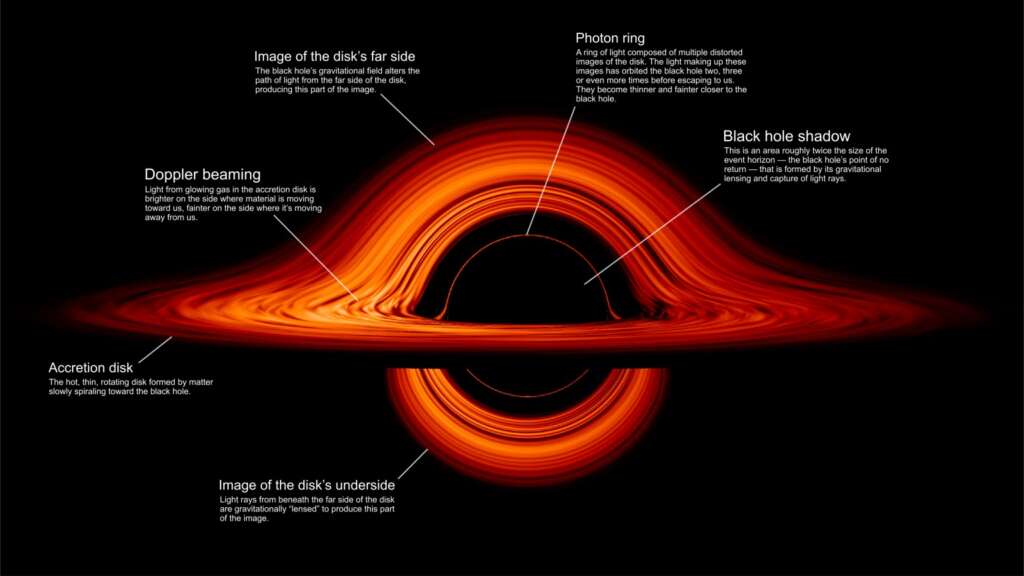The universe holds astounding mysteries that are key to knowing the answers to many intriguing questions which puzzle mankind. One of these many mysteries that the universe has is the enigma called black holes.
A black hole in space is a point where the gravity is so strong that even light, once pulled in, cannot escape. Due to light not being able to get out, black holes are invisible to the human eye. They can be identified with the help of space telescopes and special tools, however.
Many have asked over the years, ‘Is black hole real?’ To answer that question, yes, it is quite real. The concept of black holes was first put forth in theory by Albert Einstein in 1916, who, in his General Theory of Relativity, predicted that black holes existed. The term “black holes” was coined much later in 1967 by John Wheeler, an American astronomer.
The first black hole in space to be discovered was Cygnus X-1, which is in the Milky Way Galaxy in the constellation of Cygnus. It was discovered in 1964, when a pair of Geiger counters on a sub-orbit rocket had picked up on a signal. Scientists found that this signal came from a blue giant star that was orbiting a humongous object. This object was radiating X-rays which was a result of the blue giant star’s material being devoured by that object – a black hole.

How are Black Holes formed?
Now we explain how a black hole is formed. During the course of a star’s life, it generates energy by merging heavy elements in its core. As time passes, the star reaches a point where there is no more material that can be converted to energy. Now, at this point, the next stage depends on how big the star is.
A star that has a size of ten times the mass of our Sun, begins to expand and become red giants. Bigger stars begin to collapse in on itself beginning with the innermost layers. A supernova is formed when the outer layers collapse into the core and are bounced back into space.
If the core is greater than three times the mass of the Sun, it gets compressed into a smaller volume with an increase in the gravitational attraction and the escape velocity grows larger. Eventually, there comes a point when even light cannot escape and this is when a black hole is born.
Structure

So, what is inside a black hole? There are three layers to a black hole: the ergosphere, the inner event horizon and the singularity.
The entire mass of a black hole is concentrated in a small point called the singularity and this point is bordered by the event horizon. The black hole is surrounded by a region called the ergosphere where close objects are dragged into the black hole.
The two basic parts of what is inside a black hole are the event horizon and the singularity which are discussed below.
The Event Horizon
The boundary that envelopes the mouth of a black hole is the event horizon. It is at this boundary the escape velocity is equal to the speed of light. Any particle that crosses this horizon, cannot escape and based on theory is fated for ‘spaghettification’. This is due to the sudden increase in the gravity’s strength as the particle is sucked into it. This process was put into words by the astrophysicist, Neil Degrasse Tyson, like so: “While you’re getting stretched, you’re getting squeezed—extruded through the fabric of space like toothpaste through a tube.”
The Singularity
The object’s mass that lies in the inner region of a black hole is called the singularity. The singularity is so small that it has an infinite density. It has been noted that the laws of physics are most likely to break down at this point. Scientists are diligently researching the puzzling phenomenon of the singularity. There is also great research involved in developing a full theory on what goes on at the centre of a black hole.
Different types of Black Holes
Here are the different types of black holes the latest discovery on black holes have dug up:
Stellar Black Holes
When a massive star has reached the end of its life, it collapses. If the size of the collapsing star is more than 20 times the mass of our Sun, the core will not have enough strength to stop from imploding. This star collapses and creates a stellar black hole.
The size of the stellar black hole at the time of birth will depend on the size of the imploding star. However, the size does not remain the same. It grows in size as it devours the dust and gas from the surrounding galaxies.
Intermediate Black Holes
Intermediate black holes are rare and are neither too small nor too big. They are formed when many stellar black holes merge with one another. This often happens in areas where galaxies are crowded.
In the early stages of merging, the stellar black holes take a long time to merge. Eventually, they hurtle around each other in a fast manner until a large, single black hole is formed. Researchers believe that the size of these merged black holes can increase in size from 100 to about 1 million solar masses.
Although proof of Intermediate black holes is hard to come by, various studies over the last few decades have shown that these rare black holes may exist.
Supermassive Black Holes
As discussed above, black holes grow larger as they merge with each other and it is the same for supermassive black holes too. There are many theories as to how these black holes form. One of the theories is that they grow large when there is a chain reaction of colliding black holes and stars. What happens in this case is that the core of the supermassive black hole gets massive as it gulps material and eventually moves toward the centre of the galaxy.
While it makes its way to the centre, it merges with other stellar and intermediate black holes, becoming gigantic. This development can make the black hole million times the mass of the Sun over a long stretch of time.
Conclusion
We do hope this post has given you sufficient answers to questions like ‘Is black hole real?’, ‘How black hole is formed?’ and ‘What is the mystery of black hole?’ The universe is boundless and it is very difficult to determine the number of black holes that exist out there in the vast expanse of space. So far, around a dozen of these captivating black holes have been discovered. The closest black hole to humankind is about 1,600 light years from Earth.
In the known universe, there are possibly 100 billion galaxies. Each of these galaxies has around 100 million stellar-mass black holes and every second there is a new stellar-mass black hole being created.
Read more: The Recipe For A Black Hole
We have come a long way in the discovery and research of the mysterious space object – black holes. Right from setting down a structure for it through extensive research to bringing about the ground-breaking photograph of a black hole in 2019; we have gained a leap in space sciences.
Here is a super helpful video you can watch to find out yet more about these fascinating phenomena in space!

